Time for a little break, I'm journeying west leaving the misty mountains of Molatero behind me and saying hello to the land of the Belle Époque as I start to plan the painting of my Black Hat French Infantry of the Line.
It took me some time to track down some pictorial reference for the French infantry uniform of the 1900 period, but eventually I came across a lovely lithograph (left). The trouble with lithograph reproductions is that the colour tints are a little 'washy' so they really don't give a true representation of actual colour intensity.
Take the blue of the tunic, for example. The artist's interpretation of the colour suggests that - overall - it is a mid-blue. This is due to the semi-transparent nature of the colour medium used and is also an artistic 'impression' of the colour to emphasis that the tunic is, indeed, blue.
So, while this illustration put me on the right track as far as the general colour scheme for the French uniform of time is concerned I was a little suspicious about the trueness of the colours. I'd much rather have some photographic reference to go by. And once again I got lucky as I came across a rather nice photo on good old Wikipedia...
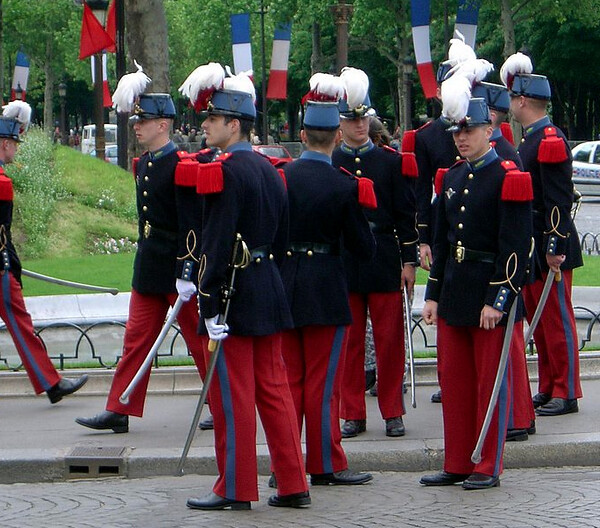 |
| The cadets of the Ecole Spéciale Militaire de Saint-Cyr, the French military academy, still wear the blue and red uniform of the French army before 1915. Source: Wikipedia (ironically, on an article on the colour 'blue'). |
"Cadets of Saint-Cyr wear in full dress (grande tenue) a special uniform, derived from the 1845 Regulations Infantry Officer Dress. This dress incorporates a dark-blue tunic, red trousers and a shako with red and white plumes. Facings are light blue, as is the képi worn on less formal occasions. Red fringed epaulettes are worn by cadets and yellow by cadet-officers. This traditional uniform was worn by both cadets and instructors at Saint-Cyr from 1845 until 1914 and then again from 1930 until 1939." Wikipedia
As you can see from the above photo the French tunic's 'blue' appears almost black and is very similar to the 'blue' of the British Police dress uniform in it's darkness. Neither is the red of the trousers a vidid red (nor a scarlet) but rather a subdued crimson (what the games paint ranges likes to call 'blood red'). It just goes to show that artists cannot be trusted! ;)
Vallejo paint equivalents
I had been rather enamoured by Tamiya acrylics because of their opaqueness, but they are rather difficult to work with. Vallejo acrylics are - I have found - a lot more user friendly and have a far wider range. I'd much rather work with a colour straight out of a bottle instead of mixing a colour, it makes it easy to replicate the same colour across numerous toy soldiers.
So I've been looking through the various Vallejo acrylic colour ranges to get the nearest equivalents to the photo reference I have. Unfortunately it look like I will have to bite the bullet and do some subtle mixing as the darkest Vallejo blues are still probably a bit light.
Colour and scale (and distance)
Ironically, after much consideration, I find myself considering taking a leaf out of the lithograph artists's book and tweaking the colour for 'effect'. The problem is one of scale and distance - that while Vallajo's 'Night Blue' might seem to be lighter than the blue Saint-Cyr cadet's tunics one must imagine the colour painted onto a 1/32 figure which will be mostly viewed from a distance of about 5 feet or so.
| Magnificent old Britains French Field Artillery set. The photo at this scale gives the impression of very dark - almost black - tunics. |
Skipping the dreary diatribe about colour theory (or am I too late) - the only way I will really get a sense of whether Vallejo's darkest blue 'fits' is actually to see it on a test figure. (And then to view that test figure at the desired distance.)
Left: Just in case I checked Humbrol's acrylic paint range too. I'm not a fan of Humbrol and in any case the closest blue they have is a gloss.
Should you really want to look into colour scaling theory then I recommend you click here: Cybermodeler Online's Scale Modeling Magazine Scale Effects in Modeling By Michael Benolkin.
So, the punchline is - if I paint my French soldiers with a the visually correct shade of midnight blue they will to all intents and purposes look like they are dressed in black tunics at arms length!
Suck it and see - my initial painting test
OK, enough talking - let's have a test. First things first, I apply a primer coat - matt white AutoKote...
Second job was to go out and buy the paints that I had chosen. As it turned out none of my local stores had them! (After all that!) So I ended up buying a small collection of what the shops did have...
Swatches
Top row: Dark Sea Blue, Imperial Blue, Dark Prussian Blue
Middle row: Dark Prussian Blue with addition of small amount of black.
Bottom row: Scarlet, Bloody Red, Flat Red.
Not perfect...I'm still going to have to do some mixing to get the 'midnight' blue I have in mind. The best mix seems to be the Vallejo Dark Prussian Blue with a dab of black in it. The crimson is a mix too, a 50/50 combination of Vallejo Bloody Red and their Flat Red.
The result...
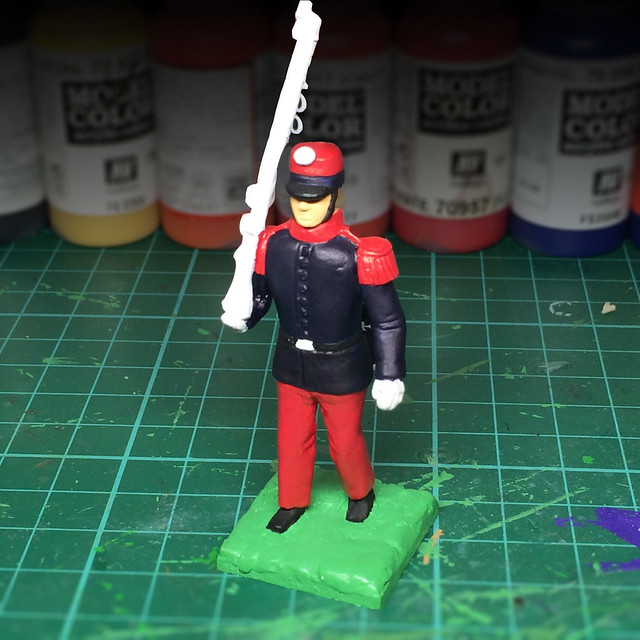 |
| Still only partially painted, but the tunic and trousers are done. |
Well, it looks like the blue and crimson in the 'Saint-Cyr' cadet photo above (I think), but the blue was tricky. I would still prefer to get the colour I want straight out the bottle as the idea of having to mix this deep blue consistently across 20 figures makes me nervous. (For some reason this mix seems to dry quite quickly so mixing up a large batch isn't feasible.)
The crimson was, however, a success and is really easy to replicate. (Phew!) My interpretation may look a little too vivid but that may be because of my cameras flash.
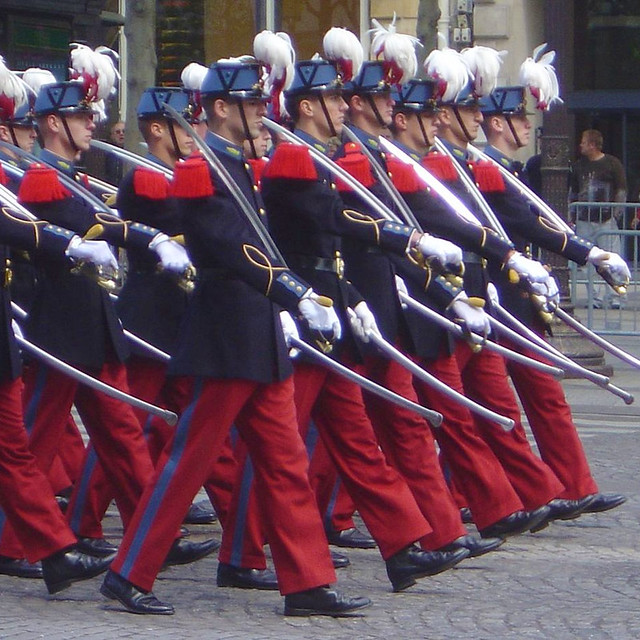 |
| 'Saint-Cyr' cadets again, be a nice future project to do a unit of these gentlemen! Source: Wikipedia. |
So, should I keep on looking for that perfect blue? I want to get this right and I'm in no hurry - my options are to investigate the Tamiya Royal Blue and also to see what Humbrol have to offer. Though straying from Vallejo means I have to order online and I like being able to pop down to my local model shop for stuff like this. (My town has just lost another model shop so it's becoming ever more important to shop in what local model stores we still do have!)
In the meantime I'll continue on with this test piece and finish it off - glossing may have a part to play in what I decide.
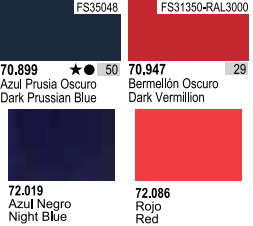


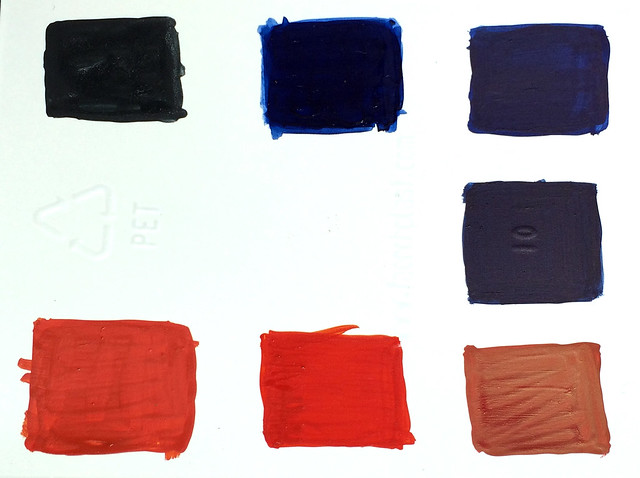
No comments:
Post a Comment